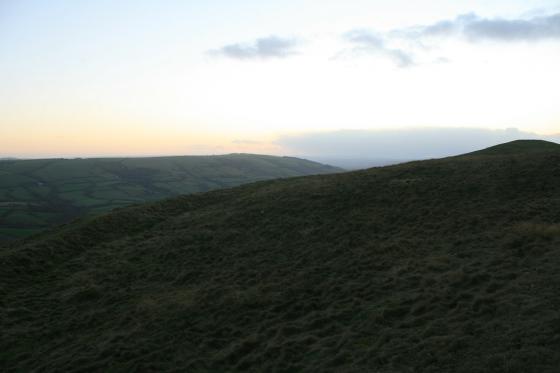



Eastern flank of the summit enclosure, looking approx north.

The excellent inturned entrance to the south...

One won’t get up that in a hurry.... I can relate from experience. However, with so much attention being accorded the local wildlife here there’s really no reason to hurry.

Another section of the seriously powerful outer bank – as far as I could tell – of this multivallate monster.




Across the powerful entrance to north-east.

To south....

To south-west...

North-eastern inner apex....

The ‘Great Fort’ is heavily wooded; however, give me sunlight and I reckon the association is a pleasing one. This is the approach from the south, the sheer size of the banks – in defensive terms, not to mention the perhaps just-as-important ‘bling factor’ – not yet apparent.

Standing at the north-eastern entrance to this magnificent hillfort.... so, which way’s it gonna be. Left, or right?

How cool is this? I want one. Now!
Iconic visitor’s on-site seating amenity presumably influenced by the discovery of a bronze boar ‘helmet emblem’ hereabouts at the beginning of the 19th century. Coflein has details here: coflein.gov.uk/en/site/407371/details/guilsfield-bronze-boar#images

Long zoom, from Offa’s Dyke Path to the ENE.
Gaer Fawr Hillfort: An Analysis of the Earthworks. A report from 2009 about the ‘Great Fort’.
A little hollow bronze boar was found at (or at least, near) the hillfort, and has been interpreted as an ornament for an Iron Age helmet. It’s also known as the Guilsfield boar. It gets a mention in ‘An inventory of the ancient monuments of Montgomeryshire‘ here:
The following extract from a letter of the 1st February, 1833, from Mr. P.G.Mytton, Garth Cottage, Llanfyllin, to the Rev. Walter Davies, is of importance:--
“If you can give me any information respecting a piece of antiquity found on Varchoel Demesne, the property of my uncle, you will very much help him and myself. It is of solid gold in the shape of a wild boar; its weight two ounces, length about two inches, and height about one; it is grooved under the belly longitudinally, the groove about 1/8th inch wide ... I have stated the size from conjecture, not having measured it; but the weight is correct.”
The hillfort itself was part of the Garth estate until the mid-twentieth century (as you can read about on the other link). Garth Hall was a rather striking building but now demolished. Calling the boar ‘solid gold’ was a bit ambitious if it’s bronze and hollow, so you can only hope he was more accurate about the animal’s origins. By 1871 Archaeologia Cambrensis seemed certain it was found ‘within [the] ancient work’ of the fort, but ‘under what circumstances it was first discovered, and whether associated with any other remains, has not been handed down.’ Ah but luckily that sort of thing doesn’t happen these days does it? Oh.
Includes a detailed description of the fort, photographs, a plan and a RCAHMW report on the site.
The full extent of a hillfort likened to an Iron Age “Millennium Stadium” has been uncovered by investigators.
Gaer Fawr hillfort at Guilsfield, near Welshpool, Powys, is effectively hidden by woodland, making it impossible to appreciate the scale of it.
Detailed survey by the Royal Commission on the Ancient and Historical Monuments of Wales produced a computer model of the site which dates from around 800BC.







































